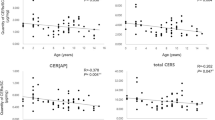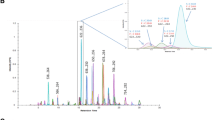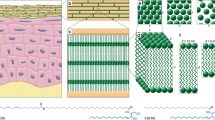Abstract
A topical acetone/diethylether (A/E) lipid extraction method was evaluated for its suitability for use in the study of stratum corneum lipids in various skin disorders. Its efficiency was compared in vitro with topical chloroform/methanol (C/M) extraction and with the classical ‘integral’ C/M extraction (submerged tissue) of stratum corneum or whole epidermis. To estimate the depth of lipid removal by A/E extraction, light microscopic and freeze-fracture electron microscopic studies were carried out on A/E and C/M topically treated skin samples. The in vivo experiments consisted of topical A/E extraction and of classical C/M extraction of scrapings of the stratum corneum. Transepidermal water loss (TEWL) was measured before and after topical A/E extraction and after every scraping procedure, and correlated with TEWL values found after stripping of the stratum corneum. The total amount of lipid found with both topical extraction procedures was lower than that found with the integral extraction of the stratum corneum. Light microscopy showed that topical C/M extraction induced cell damage in the living epidermal cell layers. Great interindividual variation in overall lipid composition was shown in the in vitro experiments irrespective of the extraction protocol used. However, the ceramide (CER) profiles in a single skin sample from the same subject were similar irrespective of the protocol used, and a uniformity in the CER profiles was found in skin samples from different subjects. Similar results were obtained with in vivo topical A/E extractions: marked interindividual variation was seen in overall lipid composition, but not in the CER profile. Furthermore, the CER profiles found using the A/E extraction procedure both in vivo and in vitro were similar. The CER profiles were also found to be identical throughout the stratum corneum, as revealed by scraping experiments. Since the CER profiles are though to play a major role in the stratum corneum barrier function, the non-invasive A/E extraction of epidermal lipids seems to be suitable for clinical application.
Similar content being viewed by others
References
Bligh EG, Dyer WJ (1959) A rapid method of total lipid extraction and purification. Can J Biochem Physiol 37: 911–917
Bowser PA, White RJ (1985) Isolation, barrier properties and lipid analysis of stratum compactum, a discrete region of the stratum corneum. Br J Dermatol 112: 1–14
Cunliffe WJ, Cotterill JA, Williamson B (1971) Variations in skin surface lipid composition with different sampling techniques. Br J Dermatol 85: 40–45
Deffond D, Saint Leger D, Leveque JL, Agache P (1986) In vivo measurement of epidermal lipids in man. Bioeng Skin 2: 71–85
Elias PM, Goerke J, Friend DS (1977) Mammalian epidermal barrier layer lipids: composition and influence on structure. J Invest Dermatol 69: 535–546
Frost P, Weinstein GD, Bothwell JW, Wildnauer R (1968) Ichthyosiform dermatoses, III. Studies of transepidermal water loss. Arch Dermatol 98: 230–233
Grice KA, Bettley FR (1967) Skin water loss and accidental hypothermia in psoriasis, ichthyosis, and erythrodermia. BMJ 4: 195–198
Grubauer G, Feingold KR, Harris RM, Elias PM (1989) Lipid content and lipid type as determinants of the epidermal permeability barrier. J Lipid Res 30: 89–96
Hartop PJ, Allenby CF, Prottey C (1978) Comparison of barrier function and lipids in psoriasis and essential fatty acid-deficient rats. Clin Exp Dermatol 3: 259–267
Herdberg CL, Wertz PW, Downing DT (1988) The nonpolar lipids of pig epidermis. J Invest Dermatol 90: 225–229
Holleran WM, Takagi Y, Menon GK, Legler G, Feingold KR, Elias PM (1993) Processing of epidermal glucosylceramides is required for optimal mammalian cutaneous permeability barrier function. J Clin Invest 91: 1656–1664
Holman BP, Spies F, Boddé HE (1990) An optimized freeze-fracture replication procedure for human skin. J Invest Dermatol 94: 332–335
Imokawa G, Hattori M (1985) A possible function of structural lipids in the water-holding properties of the stratum corneum. J Invest Dermatol 84: 282–284
Imokawa G, Akasaki S, Hattori M, Yoshizuka N (1986) Selective recovery of deranged water-holding properties by stratum corneum lipids. J Invest Dermatol 87: 758–761
Imokawa G, Abe A, Jin K, Higaki Y, Kawashima M, Hidano A (1991) Decreased level of ceramides in stratum corneum of atopic dermatitis: an etiologic factor in atopic dry skin? J Invest Dermatol 96: 523–526
Kiistala R, Lauharanta J, Kanerva L (1981) Transepidermal water loss and sweat gland response in lamellar ichthyosis before and during treatment with etretinate: report of three cases. Acta Derm Venereol (Stockh) 62: 268–270
Pinnagoda J, Tupker RA, Agner T, Serup J (1990) Guidelines for transepidermal water loss (TEWL) measurement. A report from the Standardization Group of the European Society of Contact Dermatits. Contact Dermatitis 22: 164–178
Ponec M, Weerheim A (1990) Retinoids and lipid changes in keratinocytes. In: Packer L (ed) Methods in enzymology. Academic Press, San Diego New York Boston, pp 30–41
Rajka G (1989) Essential aspects of atopic dermatitis. Springer, Berlin Heidelberg New York
Serup J, Blichmann C (1987) Epidermal hydration of psoriasis plaques and the relation to scaling: measurement of electrical conductance and transepidermal water loss. Acta Derm Venereol (Stockh) 67: 357–366
Tagami H, Yoshikuni K (1985) Interrelationship between water-barrier and reservoir functions of pathologic stratum corneum. Arch Dermatol 121: 642–645
Wertz PW, Downing DT (1983) Ceramides of pig epidermis: structure determination. J Lipid Res 24: 759–765
Wertz PW, Miethke MC, Long SA, Strauss JS, Downing DT (1985) The composition of the ceramides from human stratum corneum and from comedones. J Invest Dermatol 84: 410–412
Yamamoto A, Serizawa S, Ito M, Sato Y (1991) Stratum corneum lipid abnormalities in atopic dermatitis. Arch Dermatol Res 283: 219–223
Author information
Authors and Affiliations
Rights and permissions
About this article
Cite this article
Lavrijsen, A.P.M., Higounenc, I.M., Weerheim, A. et al. Validation of an in vivo extraction method for human stratum corneum ceramides. Arch Dermatol Res 286, 495–503 (1994). https://doi.org/10.1007/BF00371579
Received:
Issue Date:
DOI: https://doi.org/10.1007/BF00371579




